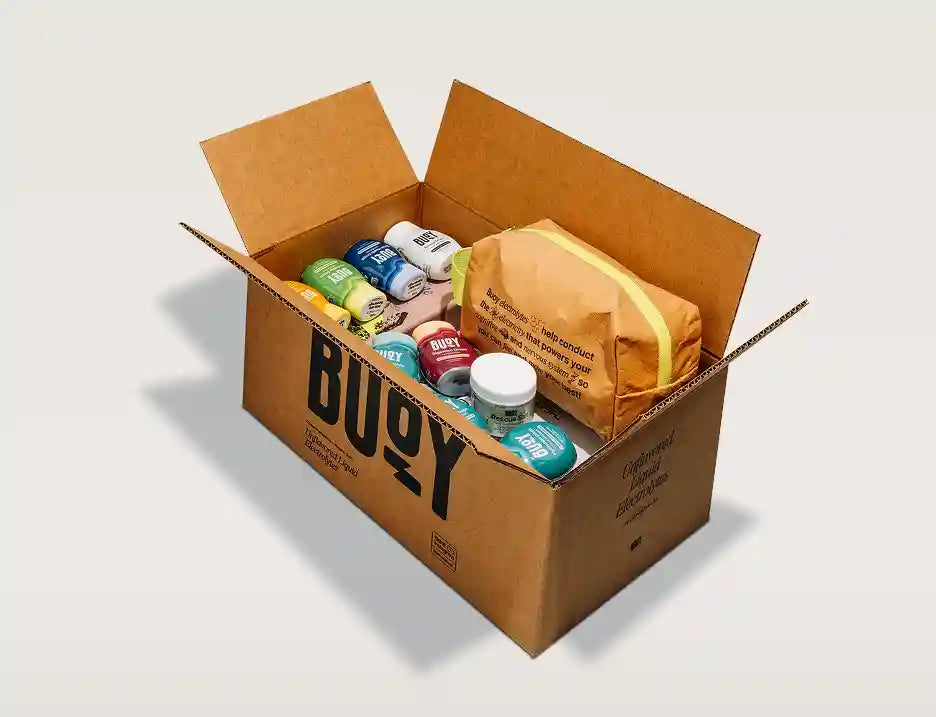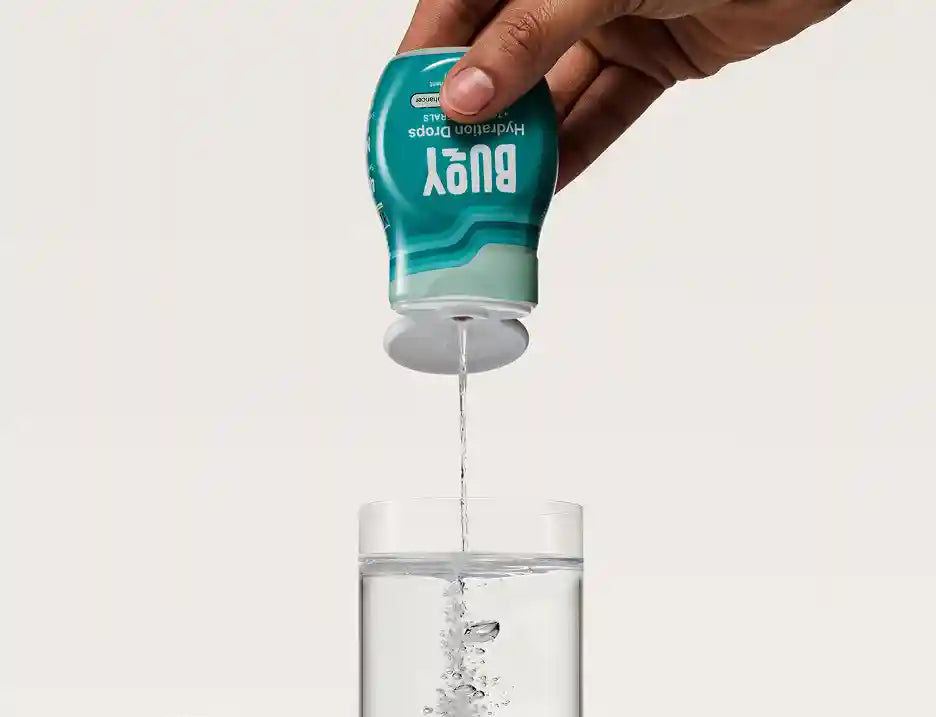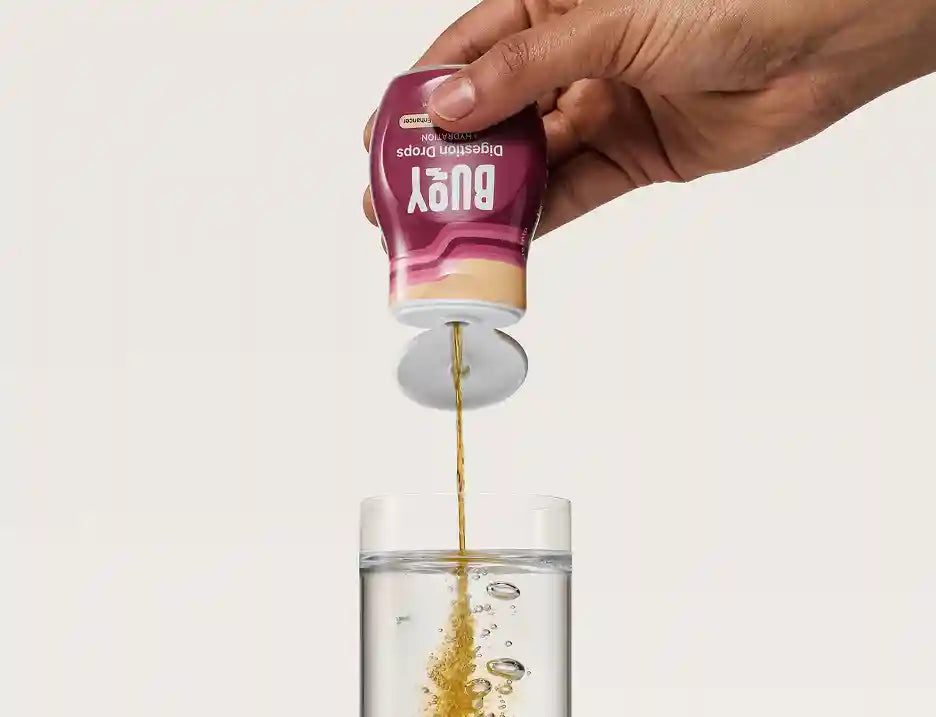
7 Everyday Signs You Might Be Low in Electrolytes
Share
Many people think electrolyte imbalance only happens after a hard workout or a bout of stomach flu, but even mild dips can show up in subtle ways long before you realize something’s off. At Buoy, we’ve seen how everyday stress, caffeine, travel, or skipped meals can quietly shift your mineral balance.
If you’ve been feeling a little “off” without a clear reason, it might be your electrolytes.
Essential Takeaways
- Electrolyte dips often appear first as small, everyday symptoms like cramps, fatigue, dizziness, or brain fog.[1][2]
- Magnesium, potassium, calcium, and sodium work together to keep your muscles, nerves, and fluid balance stable.[1][3]
- Hydration Drops deliver clean, fast-absorbing electrolytes without sugar or caffeine.
- Diet and hydration together are the best long-term fix.
- Persistent or severe symptoms should always be checked by a healthcare professional.[2]
Here’s how to spot the signs early and what you can do to fix them naturally.
- 1. Frequent Muscle Cramps or Twitching
- 2. Persistent Fatigue Despite Rest
- 3. Brain Fog, Confusion, or Difficulty Concentrating
- 4. Sudden Dizziness or Lightheadedness
- 5. Palpitations or Irregular Heartbeat
- 6. Unusual Thirst, Dry Mouth, or Swollen Hands and Feet
- 7. Digestive Disturbances: Nausea, Constipation, or Diarrhea
- Why Do Electrolyte Deficiencies Happen in the First Place?
- Buoy Hydration Drops vs. Traditional Electrolyte Drinks
- How to Build a Daily Routine That Supports Electrolyte Balance
- FAQs
1. Frequent Muscle Cramps or Twitching
Muscle cramps and twitching are classic indicators that electrolyte levels may be running low. Minerals such as magnesium, potassium, and calcium regulate how muscles contract and relax. When they drop, muscles may tighten or misfire, leading to cramps or spasms, often at night or after exercise.[1][3]
Adding magnesium and potassium-rich foods (like spinach, potatoes, and bananas) or using our sugar- and additive-free Hydration Drops can help your muscles recover more smoothly.
2. Persistent Fatigue Despite Rest
When you wake up tired even after a full night’s sleep, electrolyte imbalances may be one reason. Low sodium, potassium, or magnesium can slow nerve signalling and make muscle energy production less efficient.[1]
That means your body is working harder just to maintain normal functions. Hydration Drops provide those core minerals in a bioavailable liquid form that absorbs quickly to support steady energy.
3. Brain Fog, Confusion, or Difficulty Concentrating
Feeling foggy, forgetful, or unfocused can sometimes stem from electrolyte shifts. Electrolytes transmit tiny electrical impulses in the brain and nervous system. When they’re off, especially alongside dehydration, signal quality drops, leading to mental sluggishness or short attention spans.[1][4]
Keeping water and minerals balanced helps maintain clearer thinking and stable focus throughout the day.
4. Sudden Dizziness or Lightheadedness
If you feel lightheaded when standing up quickly, your fluid and sodium balance might be off. Sodium helps manage fluid volume and blood pressure. When it’s too low, your circulation can momentarily struggle to stabilize, leading to dizziness.[2]
Hydration Drops replace sodium in moderation, alongside potassium and magnesium, supporting proper vascular tone and reducing those sudden dips.
5. Palpitations or Irregular Heartbeat
Your heart relies on balanced levels of potassium, magnesium, and calcium to maintain rhythm. Too little or too much of any can cause noticeable flutters or skipped beats. While mild palpitations can happen occasionally, frequent or intense episodes deserve medical attention.[1][3]
Supporting consistent mineral intake and hydration rather than relying on quick fixes helps the cardiovascular system stay in rhythm.
6. Unusual Thirst, Dry Mouth, or Swollen Hands and Feet
Electrolyte imbalance affects how the body manages water. Sometimes it triggers intense thirst and dryness; other times, it leads to water retention and swelling in the hands, feet, or ankles.[2]
Both extremes signal your body’s effort to correct internal fluid distribution. Regular hydration with electrolytes (not just plain water) helps maintain balance and relieve these ups and downs.
7. Digestive Disturbances: Nausea, Constipation, or Diarrhea
Low electrolytes can disrupt digestion and cause cramps or slowed bowel movements. Meanwhile, illness, vomiting, or diarrhea can drain electrolytes further, creating a loop that keeps symptoms going.[4]
Replacing minerals through diet and Hydration Drops helps your digestive system recover equilibrium and function more smoothly.
Why Do Electrolyte Deficiencies Happen in the First Place?
You don’t have to be an athlete to run low on electrolytes. Everyday factors like sweating, stress, caffeine, alcohol, certain medications, or simply not eating balanced meals can all contribute.
Older adults and people under chronic stress are especially prone to subtle shifts. One of the most common early warnings is just feeling “off”, not sick, but not quite yourself. Using Hydration Drops daily keeps those essential minerals topped up and supports your baseline hydration quietly in the background.
Buoy Hydration Drops vs. Traditional Electrolyte Drinks
Not all hydration solutions are created equal. Many commercial electrolyte drinks include sugar, dyes, or caffeine, ingredients that can work against long-term hydration.[2]
Hydration Drops take a cleaner approach: zero sugar, no artificial additives, just fast-absorbing magnesium, potassium, and sodium in a liquid form you can add to any drink. That simplicity helps you stay consistent, and consistency is what maintains balance.
How to Build a Daily Routine That Supports Electrolyte Balance
Small, steady habits keep electrolytes in check. Here’s what a healthy routine can look like:
- Start the morning with a glass of water plus Hydration Drops.
- Include one electrolyte-rich food each meal (spinach, avocado, yogurt, or beans).
- Replenish after workouts, hot weather, or long commutes.
- Limit caffeine and alcohol, as both increase fluid and mineral loss.
- Pay attention to early signals like cramps or fatigue—and respond quickly.
Balanced hydration doesn’t need to be complicated, just consistent.
FAQs
What does electrolyte deficiency feel like?
Electrolyte deficiency often feels like muscle cramps, fatigue, brain fog, or lightheadedness. These signs occur because your muscles, nerves, and fluid systems depend on minerals like potassium, magnesium, sodium, and calcium. When levels drop even slightly, your body struggles to maintain balance, and you notice in small but persistent symptoms before anything more serious.[1][3]
Can Hydration Drops help with subtle symptoms of low electrolytes?
Yes. Hydration Drops are formulated to help with subtle symptoms of low electrolytes. Because they deliver minerals in a liquid, fast-absorbing base, they target early warning signs like fatigue, cramps, or lightheadedness. Using them alongside good hydration and a balanced diet can often ease those minor issues before they become disruptive.[1][4]
How quickly can I expect improvements after using Hydration Drops?
You might notice improvements in hours to a couple of days after starting Hydration Drops, depending on how depleted you were. Signs like reduced muscle cramps or less brain fog tend to appear sooner. More energy and more stable digestion may take a few days. Consistency is key: regular use plus sufficient water, food, and rest help the body rebuild its mineral stores.
What foods help if I’m low in electrolytes?
Foods like bananas, leafy greens (spinach, kale), potatoes, avocados, yogurt, beans, nuts, and seeds are rich in potassium, magnesium, calcium, and other electrolytes. Including these regularly in your meals supports what you get from Hydration Drops and helps maintain mineral balance naturally.
When should I see a doctor about electrolyte deficiency?
If you experience severe symptoms such as chest pain, irregular heartbeats, extreme weakness, confusion, or persistent muscle spasms, you should seek medical help. Also, if you’re using medications that affect kidney or heart function, or have chronic conditions like diabetes, don’t self-diagnose. Ask your doctor for blood tests and guidance.[2][4]
Can dehydration mimic an electrolyte deficiency?
Yes. Dehydration causes loss of water and electrolytes together. Many signs of dehydration, dry mouth, fatigue, dizziness, overlap with electrolyte deficiency. Drinking plain water helps, but without electrolyte support, hydration might feel incomplete. Using Hydration Drops during dehydration episodes can restore balance more fully.[1][2]
References
- Cleveland Clinic — Electrolytes: Types, Purpose & Normal Levels.
- Medical News Today (medically reviewed) — Electrolyte imbalance: Symptoms, causes, and treatment.
- American Heart Association — How Potassium Can Help Control High Blood Pressure.
- Zhang X, et al. Effects of Magnesium Supplementation on Blood Pressure. Hypertension. 2016.




